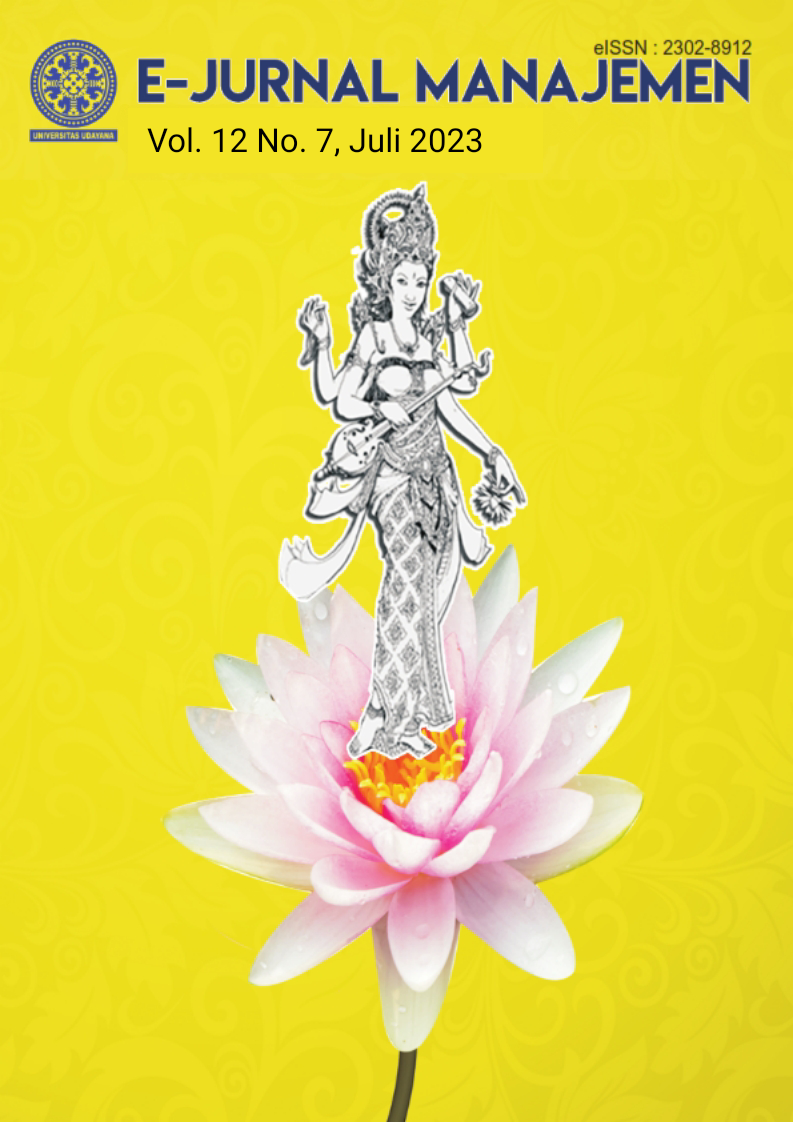PENGGUNAAN TEKNOLOGI ARTIFICIAL INTELLIGENCE DALAM PEMILIHAN PRODUK KECANTIKAN OLEH KONSUMEN WANITA
Abstrak
Penggunaan teknologi Artificial Intelligence (AI) dalam industri kecantikan terus meningkat sebagai sarana membantu para konsumen dalam pemilihan produk. Penelitian ini bertujuan untuk menguji pengaruh perceived ease of use, perceived usefulness dan norma subjektif terhadap niat untuk menggunakan teknologi AI pada pemilihan produk kecantikan. Wanita dewasa muda menjadi fokus subjek pada penelitian ini sebagai target market terbasar dari industri kecantikan. Sebanyak 105 responden menjadi sampel dalam penelitian kuantitaif dengan metode purposive sampling. Pengolahan data menggukan aplikasi Smart-PLS menghasilkan bahwa perceived ease of use, perceived usefulness dan norma subjektif secara signifikan berpengaruh terhadap niat untuk menggunakan teknologi AI. Disisi lain norma subjektif tidak berpengaruh terhadap perceived usefulness.
The use of artificial intelligence (AI) technology in the beauty industry continues to increase as a means of helping consumers in product choices. The research aims to test the influence of perceived ease of use, perceved usefulness and subjective norms on the intention to use AI technology on the selection of beauty products. Young adult women became the subject focus on this study as the most targeted market based of the beauty industry. A total of 105 respondents were sampled in quantitative research using purposive sampling method. Data processing by Smart-PLS applications results in the perceptual ease of use, perceived usefulness and subjective norms having a significant influence on the intention to use AI technology. On the other hand, subjective norms do not influence perceived usefulness.
##plugins.generic.usageStats.downloads##
Referensi
Ajzen, I. (1991). The theory of planned behavior. Organizational Behavior and Human Decision Processes, 50(2), 179–211. https://doi.org/10.1016/0749-5978(91)90020-T
Arifin, S. H. (2019). Pemasaran Era Milenium. CV. Budi Utama.
Bilgihan, A., Barreda, A., Okumus, F., & Nusair, K. (2016). Consumer perception of knowledge-sharing in travel-related OnlineSocial Networks. Tourism Management, 52, 287–296. https://doi.org/10.1016/j.tourman.2015.07.002
Chi, T. (2018). Understanding Chinese consumer adoption of apparel mobile commerce: An extended TAM approach. Journal of Retailing and Consumer Services, 44(July), 274–284. https://doi.org/10.1016/j.jretconser.2018.07.019
Davis, F. D. (1989). Perceived Usefulness, Perceived Ease of Use, and User Acceptance of Information Technology. MIS Quarterly, September, 319–339. https://doi.org/https://doi.org/10.2307/249008
Edelman, D. C., & Abraham, M. (2022). Customer Experience in the Age of AI. Harvard Business Review, 100(2), 116–125.
Hair, J. F., Risher, J. J., Sarstedt, M., & Ringle, C. M. (2018). The Results of PLS-SEM Article information. European Business Review, 31(1), 2–24. https://doi.org/10.1108/EBR-11-2018-0203
Hamid, A. A., Razak, F. Z. A., Bakar, A. A., & Abdullah, W. S. W. (2016). The Effects of Perceived Usefulness and Perceived Ease of Use on Continuance Intention to Use E-Government. Procedia Economics and Finance, 35(October 2015), 644–649. https://doi.org/10.1016/s2212-5671(16)00079-4
Hansen, J. M., Saridakis, G., & Benson, V. (2018). Risk, trust, and the interaction of perceived ease of use and behavioral control in predicting consumers’ use of social media for transactions. Computers in Human Behavior, 80, 197–206. https://doi.org/10.1016/j.chb.2017.11.010
Hasbullah, N. A., Osman, A., Abdullah, S., Salahuddin, S. N., Ramlee, N. F., & Soha, H. M. (2016). The Relationship of Attitude, Subjective Norm and Website Usability on Consumer Intention to Purchase Online: An Evidence of Malaysian Youth. Procedia Economics and Finance, 35(October 2015), 493–502. https://doi.org/10.1016/s2212-5671(16)00061-7
Kamal, S. A., Shafiq, M., & Kakria, P. (2020). Investigating acceptance of telemedicine services through an extended technology acceptance model (TAM). Technology in Society, 60(September 2019), 101212. https://doi.org/10.1016/j.techsoc.2019.101212
Kim, H. bumm, Kim, T. (Terry), & Shin, S. W. (2009). Modeling roles of subjective norms and eTrust in customers’ acceptance of airline B2C eCommerce websites. Tourism Management, 30(2), 266–277. https://doi.org/10.1016/j.tourman.2008.07.001
Kristi, K., & Kusumawati, N. (2021). Technology Acceptance and Customer Perception of Augmented Reality (AR) in Indonesian Beauty Industry. https://doi.org/10.4108/eai.22-7-2020.2307916
Kumala, D. C., Pranata, J. W., & Thio, S. (2020). Pengaruh Perceived Usefulness, Perceived Ease of Use, Trust, Dan Security Terhadap Minat Penggunaan Gopay Pada Generasi X Di Surabaya. Jurnal Manajemen Perhotelan, 6(1), 19–29. https://doi.org/10.9744/jmp.6.1.19-29
Kusumawati, R. (2018). Kecerdasan Buatan Manusia (Artificial Intelligence); Teknologi Impian Masa Depan. ULUL ALBAB Jurnal Studi Islam, 9(2), 257–274. https://doi.org/10.18860/ua.v9i2.6218
Lewis, W., Agarwal, R., & Sambamurthy, V. (2003). Sources of Influence on Beliefs about Information Technology Use: An Empirical Study of Knowledge Workers. MIS Quarterly, 27(4), 657–678. https://doi.org/https://doi.org/10.2307/30036552
Longoni, C., Bonezzi, A., & Morewedge, C. K. (2019). Resistance to Medical Artificial Intelligence. Journal of Consumer Research, 46(4), 629–650. https://doi.org/10.1093/jcr/ucz013
Martens, M., Roll, O., & Elliott, R. (2017). Testing the Technology Readiness and Acceptance Model for Mobile Payments Across Germany and South Africa. International Journal of Innovation and Technology Management, 14(6). https://doi.org/10.1142/S021987701750033X
Nagy, S., & Hajdú, N. (2021). Consumer Acceptance of the Use of Artificial Intelligence in Online Shopping: Evidence From Hungary. Amfiteatru Economic, 23(56), 1–1. https://doi.org/10.24818/EA/2021/56/155
Noor Ardiansah, M., Chariri, A., Rahardja, S., & Udin. (2020). The effect of electronic payments security on e-commerce consumer perception: An extended model of technology acceptance. Management Science Letters, 10(7), 1473–1480. https://doi.org/10.5267/j.msl.2019.12.020
Nugroho, A., Najib, M., & Simanjuntak, M. (2018). Factors Affecting Consumer Interest In Electronic Money Usage With Theory Of Planned Behavior (TPB). Journal of Consumer Sciences, 3(1), 15. https://doi.org/10.29244/jcs.3.1.15-27
Nugroho, M. A., & Fajar, M. A. (2017). Effects of Technology Readiness Towards Acceptance of Mandatory Web-Based Attendance System. Procedia Computer Science, 124, 319–328. https://doi.org/10.1016/j.procs.2017.12.161
Pangkey, F. M., Furkan, L. M., & Mulyono, L. E. H. (2019). Pengaruh Artificial Intelligence dan Digital Marketing terhadap Minat Beli Konsumen. Jmm Unram - Master of Management Journal, 8(3), 258–269. https://doi.org/10.29303/jmm.v8i3.448
Pillai, R., Sivathanu, B., & Dwivedi, Y. K. (2020). Shopping intention at AI-powered automated retail stores (AIPARS). Journal of Retailing and Consumer Services, 57(June), 102207. https://doi.org/10.1016/j.jretconser.2020.102207
Punnoose, A. C. (2012). Determinants of intention to use eLearning based on the technology acceptance model. Journal of Information Technology Education:Research, 11(1), 301–337. https://doi.org/10.28945/1744
Purani, K., Kumar, D. S., & Sahadev, S. (2019). e-Loyalty among millennials: Personal characteristics and social influences. Journal of Retailing and Consumer Services, 48(July 2018), 215–223. https://doi.org/10.1016/j.jretconser.2019.02.006
Purba, J. T. (2018). Strategic innovation through technology readiness and acceptance in implementing for corporate sustainability. 12th International Annual Symposium on Management, March, 14th 2015 in Makassar Sulawesi, Indonesia, February, 14. https://doi.org/10.13140/RG.2.2.15744.53764
Ramadhana, M. A., & Hussein, A. S. (2022). Pengaruh Penggunaan Artificial Intelligence Terhadap Customer Loyalty Dengan Citra Merek Sebagai Variabel Mediasi. Jurnal Manajemen Pemasaran Dan …, 01(4), 522–531. https://jmppk.ub.ac.id/index.php/jmppk/article/view/84%0Ahttps://jmppk.ub.ac.id/index.php/jmppk/article/download/84/63
Ririh, K. R., Laili, N., Wicaksono, A., & Tsurayya, S. (2020). Studi Komparasi dan Analisis Swot Pada Implementasi Kecerdasan Buatan (Artificial Intelligence) di Indonesia. Jurnal Teknik Industri, 15(2), 122–133. https://ejournal.undip.ac.id/index.php/jgti/article/view/29183
Santrock, J. W. (2020). Essentials of life-span development (18th ed.). McGraw-Hill.
Schepers, J., & Wetzels, M. (2007). A meta-analysis of the technology acceptance model: Investigating subjective norm and moderation effects. Information and Management, 44(1), 90–103. https://doi.org/10.1016/j.im.2006.10.007
Shin, S., & Lee, W. J. (2014). The effects of technology readiness and technology acceptance on NFC mobile payment services in Korea. Journal of Applied Business Research, 30(6), 1615–1626. https://doi.org/10.19030/jabr.v30i6.8873
Tahar, A., Riyadh, H. A., Sofyani, H., & Purnomo, W. E. (2020). Perceived ease of use, perceived usefulness, perceived security and intention to use e-filing: The role of technology readiness. Journal of Asian Finance, Economics and Business, 7(9), 537–547. https://doi.org/10.13106/JAFEB.2020.VOL7.NO9.537
Teo, T. (2009). The impact of subjective norm and facilitating conditions on pre-service teachers’ attitude toward computer use: A structural equation modeling of an extended technology acceptance model. Journal of Educational Computing Research, 40(1), 89–109. https://doi.org/10.2190/EC.40.1.d
Tseng, J., & Tzou, H. (2022). How AI and AR Can Help Beauty Industry. 7–14.
Vasiljeva, T., Shaikhulina, S., & Kreslins, K. (2017). Cloud Computing: Business Perspectives, Benefits and Challenges for Small and Medium Enterprises (Case of Latvia). Procedia Engineering, 178, 443–451. https://doi.org/10.1016/j.proeng.2017.01.087
Vrublevskaia, O. (2021). Effectiveness and universality of artificial intelligence implementation in modern marketing: media and cosmetics industry. https://www.theseus.fi/handle/10024/503288
Walczuch, R., Lemmink, J., & Streukens, S. (2007). The effect of service employees’ technology readiness on technology acceptance. Information and Management, 44(2), 206–215. https://doi.org/10.1016/j.im.2006.12.005
Zhong, Y., Oh, S., & Moon, H. C. (2021). Service transformation under industry 4.0: Investigating acceptance of facial recognition payment through an extended technology acceptance model. Technology in Society, 64(December 2020), 101515. https://doi.org/10.1016/j.techsoc.2020.101515




















